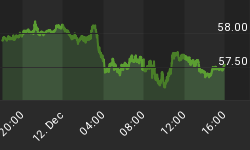Forget about NAFTA or OPEC or TPP or crowd size or hand size or any other acronym or stat or concept that obsesses the financial press these days. Only two numbers actually matter.
The first is $20 trillion, which is the level the US federal debt will exceed sometime around June of this year. Here's the current total as measured by the US Debt Clock:

To put $20 trillion into perspective, it's about $160,000 per US taxpayer, and exists in addition to the mortgage, credit card, auto, and student debt that our hypothetical taxpayer probably carries. It is in short, way too much for the average wage slave to manage without some kind of existential crisis.
It's also way more than it used to be. During his tenure, president George W. Bush (2000 – 2008) nearly doubled the government's debt, which is to say his administration borrowed as much as all its predecessors from Washington through Clinton combined. At the time this seemed like a never-to-be-duplicated feat of governmental profligacy. But the very next administration topped it, taking the federal debt from $10 trillion to the soon-to-be-achieved $20 trillion. And the incoming administration apparently sees no problem with continuing the pattern.

The other meaningful number is 6.620. That's the average interest rate the US government paid on its various debts in 2000, the year before the great monetary experiment of QE, ZIRP and all the rest began. When talking heads at the Fed and elsewhere refer to “normalizing†interest rates they're proposing a return to this 6% average rate.
But of course the last time that rate prevailed our debts were just a little lower. Run the numbers on today's obligations and you get, well, let's see:
$20 trillion x 6% = $1.2 trillion a year in interest expense. To put that in perspective...
-
It's $15,000 a year per family of four, or about a fourth of what the typical American family earns.
-
It's 31% of the federal budget, which would mean massive cuts in every other spending program.
The conclusion: It can't happen without causing one of the following:
-
Government spending cuts and/or tax increases that impose Greek-style austerity on Americans who won't respond well to their sudden demotion to Third World status.
-
A new round of monetary experiments involving the “forgiveness†of the government's debts, financed with newly-created dollars. This will work – as long as dollars remain universally accepted as a store of value. History offers no examples of such a thing.
-
An overt effort to devalue the dollar, with the goal of paying the interest in full, but (again) with newly- created, much-less-valuable currency.
The resulting dilemma: If we hope to live within our means interest rates can never be allowed to rise. But if interest rates don't rise, the Fed is forced to create a tsunami of new dollars to keep rates low, and must take its chances with inflation, currency war, crack-up boom, and all the other black swans that live in the land of monetary excess.
Which is why the sound money community keeps harping on gold. All the politically-acceptable policy options have inflation/devaluation at their core, and those things are always and everywhere great for real assets.
















